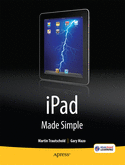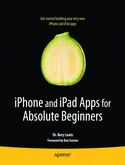From iPhone User to iPhone App Developer
I recently read somewhere that if truth be told, the iPad was not primarily developed for existing iPhone and Mac users, it was really produced for people with very little or no prior experience with computers, or specifically a Mac computer. The portable, relatively affordable Apple device was designed to reach an untapped market for Apple. Well, I don’t know how many iPads were purchased by Mac newbies, but I did briefly talk to a man in the bookstore a few weeks ago who was looking at magazines about the iPad. He noticed I was leafing through an issue of Macworld magazine and he showed me a cover story of another magazine that was about the technology that made up the iPad. He whispered to me, “See, I don’t need an article that explains the inside of the iPad, I need something that tells me how to use it.”
Though David Pogue’s first Mac OS X Missing Manual book was my Bible for a few years, I take for granted that the iPad, as well the iPhone and Mac computers and software are easy and intuitive to use.

iPad Made Simple
So where am I going with all this? Well, if you’re new to the iPad and similar devices, iPad Made Simple by Martin Trautschold and Gary Mazo (Apress Press, $29.99) will explain to you, the end user, everything you need to know, and then some, about Apple‘s new computer tablet.
When I received a review copy of iPad Made Simple, I was a little taken aback. It’s a 705 page tome, much larger and arguably more daunting than the iPad itself. But as I thumbed through it and checked out the content, I could see that it has got to be the most comprehensive book on the subject on the market today. Sure, there are smaller pocket size books about the iPad and those are useful too, but I think iPad Made Simple will appeal to Mac newbies needing to know how to get started with the iPad and other related software.
The book covers everything from connecting your new iPad to iTunes, to using the on-screen keyboard, understanding and setting up a Wi-Fi connection, playing music in the iPod app, viewing videos, connecting Bluetooth devices, setting up email, using the Maps app, sampling default and third-party apps, and learning the basics of the iTunes application itself.

The size of the book may be a bit overwhelming for some users, but it’s not a book that you will read from cover-to-cover. The authors and the publishers took special care to use very detailed screen shots (on every page) and step-by-step instructions for that can be fairly understood without having to read all the accompanying text.
iPad Made Simple is the kind of reference book users can dip into to learn something new and try it out immediately on their iPad. It opens with a Quick Start Guide for those needing a quick overview of getting set up. From there, I think most readers will thumb through and learn things as needed.
The book also covers iPad accessories including the wireless keyboard dock, the Camera Connection kit, and VGA Adapter Cable. It also introduces many of the popular iPad related apps, such the iWork suite (Pages, Numbers, Keynote), iBook, GoodReader, Evernote, and of course all the default apps that come with the device.
I wouldn’t recommend the book to experienced iPhone users, but for Apple newbies, it’s a very useful guide if you want to get the most out of the device. There’s an eBook version of the app the can be download and actually read on the iPad itself.

iPhone and iPad Apps for Absolute Beginners
If you have been a long time Mac and iPhone user you may have had an idea for an application you wished someone would build. But unfortunately, developing software is not as easy as dragging and dropping media into say iDVD and producing a nearly professional DVD with titles, chapters, and background music. Learning the language of Objective-C programing is not the same thing as even producing your own dashboard widget—remember those?
If you know nothing about UITableViewController class, switch view interfaces, objects and properties, IBActions and IBOutlets, then I can nearly guarantee that Dr. Rory Lewis’s iPhone and iPad Apps for Absolute Beginners (Apress, $29.99) is probably the best book for getting you started with mobile app development.
This book peaked my interest because I’m one of the absolute beginners that the author is addressing. I have dabbled a little in CSS and HTML languages, produced some AppleScript and Automator workflows, but none of that compares with learning Objective-C and Cocoa programming—the basis of iPhone and iPad applications.
I’ve tried a few other iPhone app development books and while the authors maintain their book is for novices, I didn’t find that the case. Sure I could work through a simple step-by-step “Hello World” program, but by the second chapter, most authors are off and driving fast, telling how to drive a car and explaining how the engine works all at the same time. One lesson I tried literally spent three chapters explaining Objective-C programming, with like one sample lesson, and then lead off the fourth chapter with, “Now that you understand Objective-C...” There’s no way you can learn Objective-C or app development by simply reading about it.

You have to get your hands—okay, your mind—dirty with writing code. For the most part, Dr. Lewis has the ability to make app development manageably understandable. He takes nothing for granted when it comes to what his readers need to know, and he doesn’t pretend that just because he spent an entire chapter explaining something that you will understand it.
Now, to be honest, what makes this book stand apart, for me anyway, is very simple. Dr. Lewis has produced instructional videos that nearly mimic the instructions in the book. These videos mirror ones he developed as part of the classes he teaches on iPad and iPhone development. In many cases, without the instructional videos I would have been completely lost. There are times in the book though, when Dr. Lewis tries to give step-by-step instructions while also explaining the why of those instructions. That makes it very difficult to follow along if you’re an absolute beginner.
So my approach has been to read parts of a chapter and follow along with the videos. Then go back and re-read the lessons that I successfully and unsuccessfully completed.
But I must admit, and say again, software development is not an iDVD production. It takes time and focus. Leaving out a semicolon, a word or two of code can mean all kinds of errors when you try to compile and run your application. It’s very frustrating to spend twenty minutes typing out code only to find that you missed something along the way. The book’s accompanying web page does include the source for you to compare your own work with. If you get stuck, I recommend opening the source code in say TextEdit and printing it out. Then go back over your own code using the source as a guide. If you still get stuck, just copy and paste the code and run it. You don’t want your small errors to prevent you from understanding the concepts.
So coding is for those with patience and a determination to learn. However, I think, having worked through about two-thirds of the book, I can tell you that iPhone app development is not rocket science. It is indeed possible to produce many of the types of basic apps uploaded to the app store on a daily basis. I think this type of programing could be learned without taking a class, though a course on the subject would probably get you much further.
By the end of chapter of six, Dr. Lewis highly recommends re-doing the lessons of each chapter, like 10 to 15 times. I couldn’t concur more.
What’s great about this book is that Dr. Lewis revisits a few basic concepts in each lesson. So by the first nine lessons, you get a working understanding of some basic tools of programming, because you have done them more than once. But then there’s the leap you must gain by understanding how things are running under the hood, so to speak. You must understand how the code makes things happen, which is the most difficult part.
There are some errors in the book that I have reported to Dr. Lewis, and if I’m correct I hope he posts them on his Errata page. But for the most part, I think if you are an absolute beginner like myself, with some time and patience, you can work through this book. (If you’re like me and have an absolute beginner's interests in iPhone app development, write me. I’d be glad to share what little I’ve learned so far.)
And by the way, the book instructs you to download the current version of iPhone SDK, which will cost $99. But you can use the X-Code application, Interface Builder, and the iPhone simulator that comes installed on the Mac OS X Snow Leopard DVD. So far, I have successfully used updated versions of these programs to complete lessons in this book. When I think I’m ready to learn more and produce my own app, I’ll pay for the iPhone SDK.
iPhone and iPad Apps for Absolute Beginners will probably not be the only book you’ll need to produce your own iPhone and iPad apps, but it is the book to help you get started.


Comments
Nice write-up. I think a lot of times us geeks forget that the vast majority of the gadget-buying population could care less about the specs, they just want the thing to work and understand how to use it to its fullest.
Interestingly enough, I think a lot of magazines miss that important point. Gone are the tutorials and projects that used to occupy the majority of the space in magazines like MacWorld, and more often the majority of pages are devoted to regurgitation of industry news and reviews of equipment. That’s great and all, it’s just that the Web is chock full of this kind of information - it smacks you in the face at every turn.
And speaking of MacWorld, does anyone else notice that the bigger and more successful Apple is, the less pages it seems to contain. Seems like it exists merely to stuff the rare tidbit of useful information between ads.
Interesting. Like you I’m a newbie when it comes to coding. I’ve also worked with css and html - plus a little php given my love for wordpress based websites. I’ve thought of developing apps, but felt it was beyond my novice mind’s ability to handle. The book sounds interesting and worth checking out.
Cheers,
JB
I was interested a bit in the CSS and HTML languages, produced some AppleScript and Automator workflows, but none of this compares to learning Objective-C and Cocoa programming database applications for the iPhone and the iPad.contractor accountants
It is so hard to find real information on the blog. eden pure heater reviews really enjoyed reading this post. It has strengthened my faith more. You all do a great job in such a concepts.can t ‘tell you how much I appreciate for all you do.